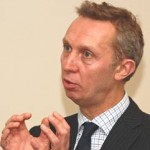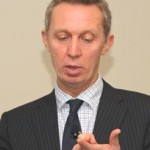January 10, 2011
Space Debris – Danger in Orbit
Dr Richard Crowther
Report by: Chris Gadsden
This was a lecture delivered by Prof Richard Crowther who is currently in charge of International Relations at the UK Space Agency, having previously been at the Space and Technology Facilities Council. He began by explaining the consequences of human space activities. These include: a greater appreciation and understanding of Earth and Space; many unique and useful applications; negligible global impact on the Earth environment; and significant impact on the Space environment which is no longer sustainable.
Debris in space continues to grow and grow – the same as is happening on the Earth’s surface. And what is in orbit around the Earth? — about 12,000 tracked objects, with a size greater than 10 cm, concentrated in distinct orbits. There are several categories of tracked objects:
- Operational spacecraft (approx 6% of space objects)
- Fragments, from more than 200 break-up events, plus collisions, propulsion materials (“slag”) and human waste
- Defunct spacecraft
- Rocket bodies
- Mission-related objects
There have been several collisions in space over the years, the first between two tracked objects occurring in 1996, but they have all been between relatively small objects resulting in a minor increase in space debris. He went on to describe the collision between two large tracked objects almost two years ago. This was between a Russian spacecraft and one of the USA’s Iridium communication satellites which Richard presented as a computer-simulated graphic clearly showing the vast amount of debris that was created by this one event.
The missile early warning system at Fylingdales can track objects down to 10 cm, but to get an estimate of the debris population that exists in space, most of which is too small to be tracked, witness plates are sometimes attached to the outer casings of satellites. These plates are later examined to determine the number and size of “hits”. Impacts on the Hubble Space Telescope are also logged.
The estimated debris population is as follows:-
| SIZE | POPULATION | % MASS |
| >10cm | 12,000 | 99.93 |
| 1 -10 cm | 100,000 | 0.035 |
| < 1 cm | 35,000,000 | ? |
Richard presented a graph showing the number of catalogued objects in space from 1955 to 2008. This shows a progressive increase throughout the period with a sharp increase in 2007 when a Chinese anti-satellite test rocket destroyed an old weather satellite and created up to 800 items of debris in Space.
A further interesting fact was that the Space Shuttles have had 90 windows replaced which had been damaged by space debris. One technique employed to reduce damage to the Shuttle is to ensure that when the loading bay doors are opened in space, the craft is orientated such that any debris fragments will tend to strike the outer casing rather then the more vulnerable internals of the craft. Damage to internal items exposed by the open doors could be catastrophic if such components as the thermal management system were punctured.
For the future, space activities need to be regulated to ensure these are sustainable for future generations. In particular debris trajectories need to be predicted and residual propellants in spacecraft should be depleted where possible. It is proposed to have two protected regions in space, viz the Low Earth Orbit Region for satellites with orbits up to an altitude of 2,000 km, and the Geosynchronous Region for high altitude satellites.
Much work is put into predicting and avoiding major collisions. One method involves modifying the orbit of a satellite or space craft so that it is not on a collision course with another object. However, this involves carrying additional propellant which is expensive. ‘Shielding’ is also used in certain cases, whereby plates are attached to the outside of the craft in order to protect vulnerable parts. Here again, this is expensive as it adds weight and therefore fuel.
Where major, and defunct, objects might pose a risk to other space craft these can be manoeuvred into a ‘graveyard orbit’ where they will pose no future threat. But of course this is also an expensive procedure involving an additional rocket to push the dead object into another orbit.
Finally, Richard described the demise of the MIR space station. Due to safety and cost concerns the Russians decided in the late 1990’s to abandon this station and destroy it. This was achieved in 2001 by de-orbiting the station in a controlled way and allowing the remnants to crash into the South Pacific Sea, thus removing 140 unwanted tons from space. Nevertheless, man-made debris now dominates in Space and the problem caused by its unsustainable growth needs to be solved within 10 years.
This concluded a fascinating lecture, delivered to an almost full-house, which was followed by a lively Q & A session.
 |
 |
Read & See More at —
Posted under: Flamsteed, Flamsteed Lecture, Meeting Report


You must be logged in to post a comment.